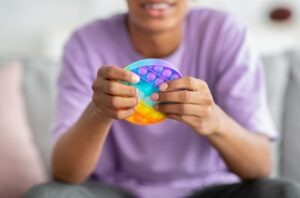People often think sensory support means setting up picture-perfect activities, obstacle courses, or buying loads of sensory equipment to meet their child’s needs.
And I get why you might think that.
I used to believe that too, especially in my early OT days, nearly 27 years ago.
The Sensory Gym Myth
Back then, I worked in a clinic filled with incredible equipment:
-
all kinds of swings (tire swings, platform swings, “hug” swings),
-
a bouncy pogo stick,
-
hammocks, crash pads, climbing walls,
-
scooter boards and ramps to whizz down…
-
even a zipline ending in a massive ball pit.
It was fun, and the kids loved it. But parents would often ask me:
“How do I recreate this at home?”
The truth is… you don’t have to.
What Matters Even More
That kind of equipment is great, but two things matter far more:
-
Connection with a safe person (YOU).
Feeling safe with you is more regulating than any swing or climbing wall. -
Understanding your child’s sensory needs.
Once you know what helps them, you can start weaving it into everyday life—no fancy equipment required.
An Everyday Example
Take my son. He’s always needed heavy muscle and joint input. The kind of grounding activities that help him feel his body and know where he is in space. That’s why he gravitates toward climbing, lifting, carrying, and even origami.
On our recent holiday, he spent ages climbing big rocks by the water. Then he started skipping stones with the biggest rocks he could find. Soon he wanted more of a “bang,” so he began throwing heavy rocks into the water, sometimes with both hands at once, delighting in the biggest splash possible.
It wasn’t planned. It wasn’t structured. It was simply what his body needed in that moment, evolving naturally into play while I sat nearby sometimes just watching and sometimes “sportcasting” for connection.
Sensory Support Made Simple
This is what I want parents to know: sensory support doesn’t have to be complicated.
It doesn’t require a sensory gym, a shopping list of equipment, or hours of preparation. It starts with understanding your child’s unique sensory profile, and then finding simple, natural ways to meet those needs in everyday life.
Want Help Figuring Out What Your Child Needs?
What works for one child may not for another. That’s why individualised support makes such a difference.
Through my 1:1 Brainstorm Sessions or video-based informal assessments, I help parents:
✔ understand their child’s sensory profile,
✔ uncover what’s going on under the surface, and
✔ build supports into daily routines in a way that feels natural and doable.
👉 [Learn more about 1:1 support here]



